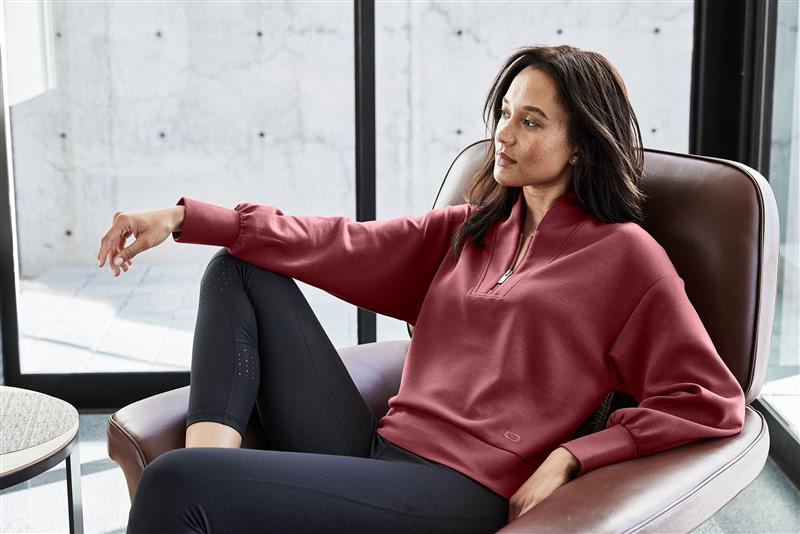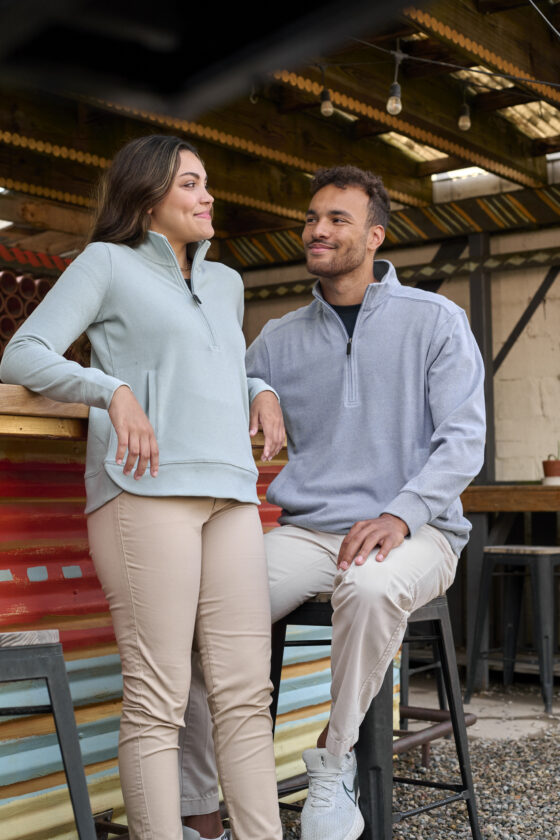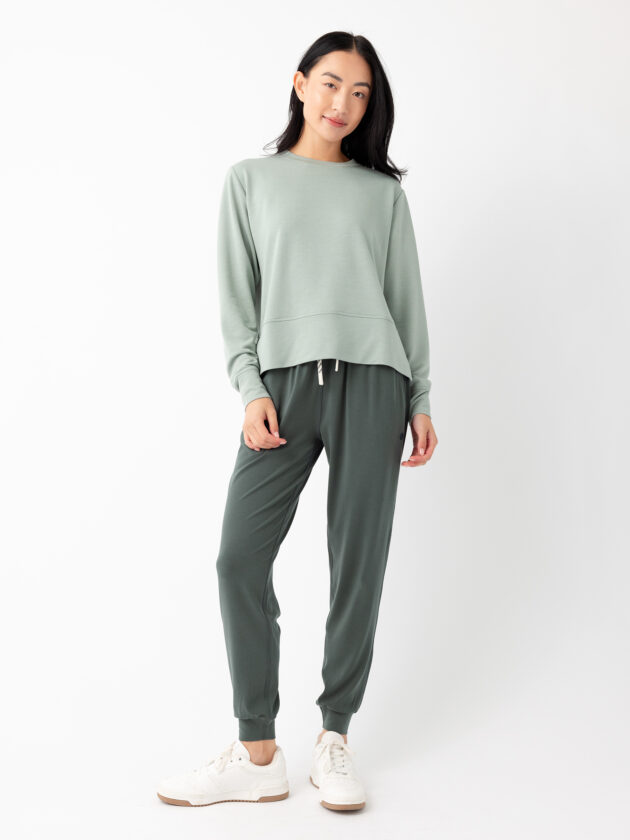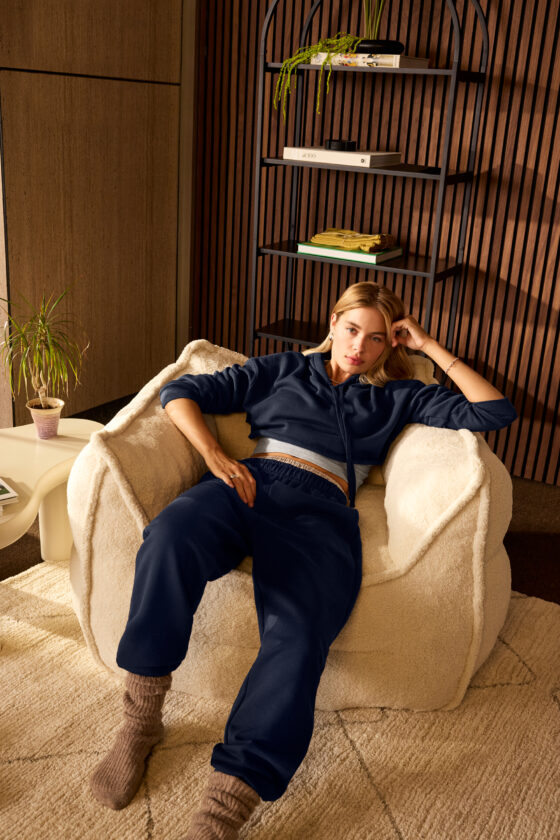For years, loungewear was relegated to sleeping in and vegging out. Slouchy sweats, fuzzy socks and other cozy basics may have been perfect for lazy days on the couch, curling up with a good book or other homebody pursuits, but comfort-first clothing had limited appeal for either couture or the corporate world.
“Loungewear used to be considered a category on the fringe, just outside of pajamas, so comfy and casual that leaving home in it was unlikely,” says Shelley Renning, vice president of merchandising for Counselor Top 40 supplier SanMar (asi/84863).
But as social strictures have relaxed, so too has style, and consumers are increasingly seeking to inject softness and stretch throughout their wardrobe, looking for pieces that carry them from work to play to relaxation afterward.
Modern loungewear “has shifted from at-home-only to everyday, versatile wear,” says Megan Boyda, sales operations coordinator at Cozy Earth Holdings (asi/46816). “Today, loungewear can be both workwear and lifestyle wear. People no longer want to swap comfort for professionalism. They want both.”

For distributors, loungewear equals opportunity. Hybrid work, employee gifting, wellness initiatives and even traditional uniforms are now comfort-driven, creating demand across sectors from healthcare to hospitality.
Loungewear Elevated
So, what exactly does loungewear entail these days? In the retail world, consider apparel lines like BeCalm from Lululemon and AirEssentials from Spanx. Or the viral weighted hoodies from Comfrt that are said to mimic a hug, activating the nervous system and thus reducing stress and anxiety.
“People want to look stylish but feel good while doing the daily grind,” says Shari Hoffman, director of marketing at Dryvve (asi/154912). Retail loungewear lines are “focused on breathability, softness and versatility, perfect for lounging, fitness or heading out to run errands.”
Tri-blends, garment dye, premium fleece, quarter-zips and matching sets all fall into the realm of loungewear. Comfort, apparel experts say, no longer has to equate to sloppiness, thanks to thoughtful touches and modern fabrications that elevate basic pieces.
“It’s in the details,” says Victoria Novosel, senior director for brand and creative marketing at BELLA + CANVAS (asi/39590). “Is the weight of the fabric, the dye process, fabric finishing and construction exactly right to provide the drape, fit and color our customers expect?”

Brushed fleece interiors, modal blends, hoods without drawcords or specialty stitch detailing are among the touches that take apparel staples like tees and hoodies to the next level, says Glen Brumer, sales director at Royal Apparel (asi/83731).
Sustainable options, like certified organic cotton for a soft hand feel, are also key, he notes. “Comfortwear has become the new everyday uniform,” he adds. “What sets brands apart now is not just softness, but storytelling – sustainability, made-in-the-USA production and authenticity resonate with today’s buyers.”
Another trend? Oversized and looser unisex silhouettes. “Unisex garments have been outperforming companion styles for the last couple of years,” says Steve Zimmerman, vice president of sales at J. America (asi/62977).
Who’s Buying Loungewear?
While Gen Z and millennials tend to drive trends in loungewear, that doesn’t mean older generations are uninterested. “Gen X and boomers respond well to [this category], especially when items emphasize quality, durability and practicality,” Hoffman says. “For branded merch distributors, there are many practical verticals where the loungewear phenomenon can take off.”
Loungewear can be an integral part of holiday gifting strategies, employee onboarding kits and company store programs for a range of industries. But different teams have different needs when it comes to comfort apparel, says Andrew Ward, president of Merchology (asi/169169).
Hybrid teams tend to like a versatile approach with layer tees and quarter-zips that easily swap between home and the office, he says. Remote teams appreciate sweatshirts in various silhouettes, like crewnecks, to “provide a variety of polished, yet comfortable looks.” And for onsite teams, think about sweatshirts or softshell jackets, which can make for great uniforms that are both practical and comfortable, Ward explains.
“Employees love pieces they’ll actually wear outside the office, which keeps the brand visible and recognizable,” Hoffman says.
Other markets to target with loungewear include schools, fitness boutiques, hotels and resorts. Also look toward the healthcare industry, where the emphasis on comfort has trickled into uniform design. “Scrubs from brands like FIGS and Jaanuu are increasingly requested for their athleisure-inspired look and soft fabrics that can be worn comfortably all day on the job,” Ward says.

‘Samples Are Essential’
When it comes to selling apparel, samples have always been important, but they’re even more crucial when it comes to loungewear. How better to explain the softness, stretch and weight of a particular garment than by holding it in one’s hands? Feeling, rather than seeing, is believing.
“A hoodie or jogger they can try on will close the deal faster than a spec sheet,” Hoffman says. “Samples are essential for showing value and helping clients visualize how their audience will wear and love the product.”
Merchology has a free sample program that lets customers test the fit and experience key features detailed on its website, all before making a final purchase, Ward says. “This hands-on experience makes it easy to understand the differences between our good-better-best options presented online and gives customers the confidence to select the right option for their team and budget,” he adds.
Samples are also key when it comes to exploring decoration options that will market their brand more effectively than the standard “left chest full back” placement, says Jessica Joyce, owner of Fully Promoted Towson (asi/384705).
“By showing them different techniques, placements and styles, and thinking outside the box, it helps get the creative juices flowing and creating a trendy look that people want to wear.”
Don’t forget the power of minimalism, however. “Decorating these products with a simpler and less in-your-face graphic helps finish the item off for our industry,” Zimmerman says.
Client education is also paramount, particularly for customers who may have outdated notions about the apparel category. “Stress that loungewear isn’t just sweats,” Hoffman says. “Elevated silhouettes, sustainable fabrics and versatile styling make these pieces part of daily wardrobes, ensuring the brand gets repeated exposure.”

6 Tips for Decorating Loungewear
With comfort pieces leaning into more premium fabrications and elevated detailing, it’s crucial for distributors and decorators to level up their embellishment as well. Try one of these trends to help loungewear leave a lasting impression.
- Minimalist embroidery: Subtle logo placement – perhaps at the neckline or cuff – pairs well with loungewear. Consider tone-on-tone stitching to deliver a polished, retail-inspired look. Or personalize a crewneck with a chain-stitched name in a cursive font to give it a vintage, hand-stitched look.
- Oversized logos & streetwear vibes: For a younger, hipper crowd, bold prints across the back of a garment or down the legs are trending. This taps into the streetwear aesthetic while giving strong visibility to brands willing to try the look.
- Monochrome palettes: Matched sets, particularly in soft neutrals, are hot sellers in loungewear. When it comes to decoration for such pieces, it’s important not to pull focus from the monochromatic vibe. Tonal prints or high-gloss clear inks add a luxe, but understated, feel.
- Hem tags: A custom woven label, featuring the client’s logo, gives just the right pop of branding to a garment while also mimicking the look of popular retail styles. Done well, a hem tag enhances the perceived value of a garment, showing off a brand without being overwhelming.
- Unique placement: Think beyond the left chest. Consider adding embellishment down the sleeve, on the hood, at the back of the neck, on a pocket or wrapping a print around the side of a garment. Putting logos and graphics in unexpected places helps to improve brand recall.
- Textural decoration: Flock printing, high-density puff and other tactile techniques resonate with comfortwear’s cozy, touchable appeal, giving designs an extra pop. The classic varsity-style look of appliqué – think chenille or tackle twill – also fits into this category. Another option? Raw-edge, distressed appliqué reinforces the relaxed, broken-in feel of loungewear.



